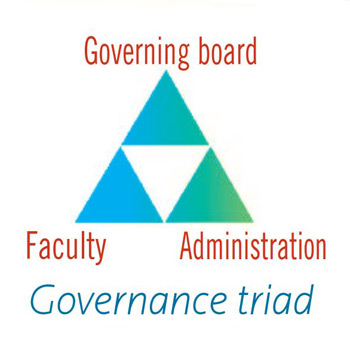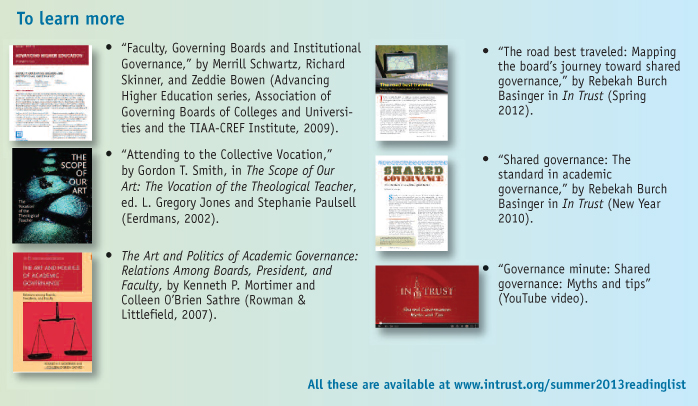LAST FALL, I was privileged to teach a course on academic governance as part of Messiah College’s new online master’s program in higher education. My students were all 20-somethings, a few years past their undergraduate programs and, if employed, in entry-level administrative positions. Most had a civics class understanding of governance, but they hadn't thought of it as having much to do with colleges and universities. As for that sacred artifact of higher education, “shared governance” — it was a new concept for them.
Seventeen blank slates, mine upon which to write the rules of how power is distributed and decisions are made in higher education settings.
Long years in the company of doubting board members, jaded administrators, and recalcitrant faculty had almost done me in. But eight weeks with these administrators-in-the-making restored my confidence that shared governance makes sense. Better yet, that it can be understood — if people are given a chance to learn.
Unfortunately, structured opportunities for learning about shared governance are rare in academic settings, including boardrooms. Unlike the students in my course, board members, presidents, other administrators, and faculty usually pick up the facts of governance on their own.
However, the evidence says that learning by osmosis isn't very effective. A 2009 study co-sponsored by the Association of Governing Boards (AGB) and the TIAA-CREF Institute found that trustees tend to understand the role of faculty in institutional governance about as well as faculty members understand the board. That’s not something to be proud of — about 23 percent say they understand the other’s role “well” or “very well.” (See the study here: www.intrust.org/summer2013readinglist.) Administrators’ knowledge of the governance prerogatives of the others isn't much better. As a result, there’s a lot of governance misinformation blowing around.
Requiring that board members, administrators, and faculty enroll in a course on academic governance isn't going to happen. So for a realistic alternative, here’s an outline for a learning plan that can be adapted to individual schools:
-
Maximizing orientation. Board members, administrators, and faculty participate in a well-planned, multisession orientation program on shared governance.
-
Mixing it up. Governance stakeholders rub shoulders and learn from each other through structured learning opportunities.
-
Holding one another accountable. Governance parties together ensure everyone’s participation in governance processes.
Maximizing orientation for good governance
Almost all theological schools provide orientation for new faculty members, sometimes including administrators as well. Similarly, most boards have gotten the message that new member orientation is a best practice. However, these are frequently one-off events, jam-packed with institutional trivia but without much mention of the roles and responsibilities of the various governance stakeholders.
Fortunately, at schools that already have some time set aside for orientation activities, there’s no need to carve out more time from overcrowded board agendas. It’s simply a matter of using some of that already scheduled time to educate new and continuing members about the governance practices you want.
Both new and old board members should be introduced to the governance story of the institution along with the documents that support it — bylaws, handbooks, and policy manuals. And it’s worth explaining shared governance and how the concept plays out on the ground.
That said, you don’t want to get hung up on language. While it’s important that new and experienced board members understand shared governance (and are comfortable with the term), framing orientation conversations in ways that participants understand is key — and that may mean dropping some of the more technical governance language. The goal is to develop within your board an understanding of how governance works in your own institution, building in board members the ability to participate actively and shape the culture of the institution.
Mixing it up
 Sometimes learning comes through words; at other times, it comes by doing. Informal interaction among stakeholder groups is a great way to encourage ownership for, understanding of, and learning about academic governance. It’s good to mix it up — to open the doors of the organizational silos in which faculty, administrators, and board members live.
Sometimes learning comes through words; at other times, it comes by doing. Informal interaction among stakeholder groups is a great way to encourage ownership for, understanding of, and learning about academic governance. It’s good to mix it up — to open the doors of the organizational silos in which faculty, administrators, and board members live.
It’s my experience that theological schools excel in this area. At most schools, smallness makes it possible for faculty, administration, and the board — and sometimes students as well — to gather in a single room for food, worship, or discussion. Board members and faculty serve side by side on committees. And it’s not unusual for faculty and students to attend board meetings.
During the past year, I've led educational sessions on two campuses at which the board invited faculty members to join them in a conversation about shared governance. For many of the participants, it was a first opportunity to hear the other side reflect on their roles and responsibilities. Although the conversations were initially tentative, as the sessions progressed, representatives from all sides of the governance triad were willing to name governance difficulties and propose better ways forward.
In the words of one of my wise young Messiah College students, “For a Christian institution, the matter of shared governance ultimately comes down to our responsibility to live in community. . . . If we are to take seriously Paul’s vision of the church as the ‘body of Christ’ (1 Corinthians 12:12-31), then we must acknowledge and encourage the legitimacy of one another’s involvement in the governance process.”
Holding one another accountable
Insufficient time, lack of mutual understanding and respect, governance policies and practices that are unclear or out of date, and the complexities of higher education — these are all governance problems cited in the AGB/TIAA-CREF report. But the biggest challenge of all is a general lack of interest.
You've heard the adage about horses and water. When applied in institutional settings, the old saying reminds that we can orient, educate, and provide opportunities to be part of shared governance, but we can’t make individuals act. As Kenneth P. Mortimer and Colleen O’Brien Sathre urge in The Art and Politics of Academic Governance, “To do the good, meritorious work of educating students, it is essential that the faculty, administrators, and boards share the governance of the academy. They need to take responsibility as a whole for the governance of their institution as a whole.”
At the end of the day, shared governance requires that people are willing to share. The faculty voice in decision making is dependent on the extent to which individual faculty members are willing to devote time to governance — even when the work is tedious. The same is true for the board. The health of a governance system thrives when everyone does his or her part.
Lesson heard
In the final week of my course, I asked students to craft a case for shared governance aimed at naysayers. Their responses blew me away. As the following statement from another of my students gives evidence, they really got it.
“Is shared governance sometimes clumsy and slow? Sure. But in the end, it ensures participation from groups with various perspectives and strengths in the process of making important decisions to improve and sustain the institution. I think that makes it worth it.”
He and the other 16 reaffirmed my conviction that it is possible to teach the governance we want. I encourage you to give it a try.
